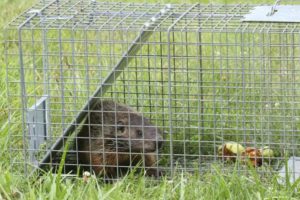Groundhogs Removal / Woodchucks Removal Service – Michigan
Woodchuck / Groundhog (Marmota monax)
 Woodchucks or groundhogs, same name for same species, are prominent throughout Michigan and are very capable of causing extensive damage through their feeding and burrowing habits. Their underground tunnel systems can reach as deep as five feet and extend up to nearly 70 feet in length.
Woodchucks or groundhogs, same name for same species, are prominent throughout Michigan and are very capable of causing extensive damage through their feeding and burrowing habits. Their underground tunnel systems can reach as deep as five feet and extend up to nearly 70 feet in length.
 Woodchucks are serious agricultural pests. Not only do they travel considerable distances to raid gardens, but their immense burrows damage farm machinery and destroy building foundations.
Woodchucks are serious agricultural pests. Not only do they travel considerable distances to raid gardens, but their immense burrows damage farm machinery and destroy building foundations.
Woodchuck / Groundhog Sound:
Habitat
Typical woodchuck habitat includes rolling farmland interspersed with grassy pastures, small woodlots, and brushy fence lines. Truth be told, they are often found in our own backyards.
Physical Description
The woodchuck is the largest sciurid in its geographic range. It has a heavy, chunky body (18-26 in) set atop relatively short but powerful legs well adapted for digging. Males are slightly larger than females. The dark-colored, bushy tail is about one-fourth as long as the total body length, much shorter in comparison to other squirrels. The woodchuck also possesses three nipple-like anal glands, which secrete a musky odor.
Behavior
Woodchucks are the most solitary marmots although several individuals may share a single den. Woodchucks are usually highly agonistic. Though observed mostly on the ground, woodchucks have been seen climbing trees to reach food and swimming with only their head and nose above water. Woodchucks are considered diurnal in their aboveground activities, although they have been observed feeding in dim light or even at night, especially when food is scarce.
When not feeding, woodchucks sun, scratch, and preen themselves outside their den while watching for potential enemies. Woodchucks are very vocal mammals, hence the name “whistle-pig.” When alarmed, a woodchuck gives a loud, shrill whistle. Teeth grinding and chattering are common when woodchucks are cornered. Woodchucks have also been heard to bark, squeal, and whistle when fighting with other woodchucks.
Dens are situated in well-drained locations. With strong, clawed, forelimbs and large teeth, woodchucks can easily construct burrows with as many as five entrances. A plunge hole is often near the major den entrance and may have a vertical drop of as much as 2 ft to a main tunnel. Horses have been known to break their legs when stumbling into these burrows. These dens are also very long, up to 45 ft of tunnels, extending as far underground as 5 ft. Dens in open areas are used in the summer, and those under stumps, at the edge of rock ledges, and near other protection are generally occupied during the winter hibernation. Dens are always kept clean and well padded. Occupied dens can be recognized by a pile of fresh earth at the entrance. Nesting chambers are about fifteen inches in diameter and are usually sparsely lined with dry leaves.
Serving Southeast Michigan
Oakland County Groundhog Removal Service
Auburn Hills | Berkley | Birmingham | Bloomfield | Bloomfield Hills Twp.| Clarkston | Commerce | Highland | Milford | Novi | Farmington | Farmington Hills | Highland | Keego Harbor | Lake Orion | Ortonville | Rochester | Rochester Hills | Royal Oak | Southfield | Troy | Union Lake | Walled Lake | Waterford | West Bloomfield | White Lake | Wixom
Wayne County Groundhog Removal Service
Canton | Livonia | Northville | Plymouth | Wayne
Livingston County Groundhog Removal Service
Brighton | Fowlerville | Hartland | Howell | Pinckney | Whitmore Lake
Macomb County Groundhog Removal Service
Centerline | Clinton Township | Fraser | Macomb Township | Roseville | Shelby Township | Sterling Heights | Utica | Warren

